Hotpoint Ariston TD 720 MT, TD 720 MST, TD 730 MT, TD 730 MST, TD 740 MT Instruction Manual
...
TD 720 MT
TD 720 MST
TD 730 MT
TD 730 MST
TD 740 MT
TD 740 MST
TO 740 AS
Piano di cottura da incasso 70 |
|
Istruzioni per l'installazione e l'uso |
2 |
Built-in cooking tables 70 |
|
Instructions for installation and use |
10 |
Plans de cuisson à encastrement 70 |
|
Instruction pour l'installation et l'emploi |
18 |
Inbouw-kookvlakken 70
Gebruiksaanwijzingen voor de plaatsing en gebruik 27
Encimera empotrable 70 |
|
Instrucciones para la instalación y uso |
35 |
Placas de encastre 70 |
|
Instruções para a instalação e o uso |
43 |
EINBAU-KOCHMULDE 70 |
|
Informationen für installation un gebrauch |
51 |
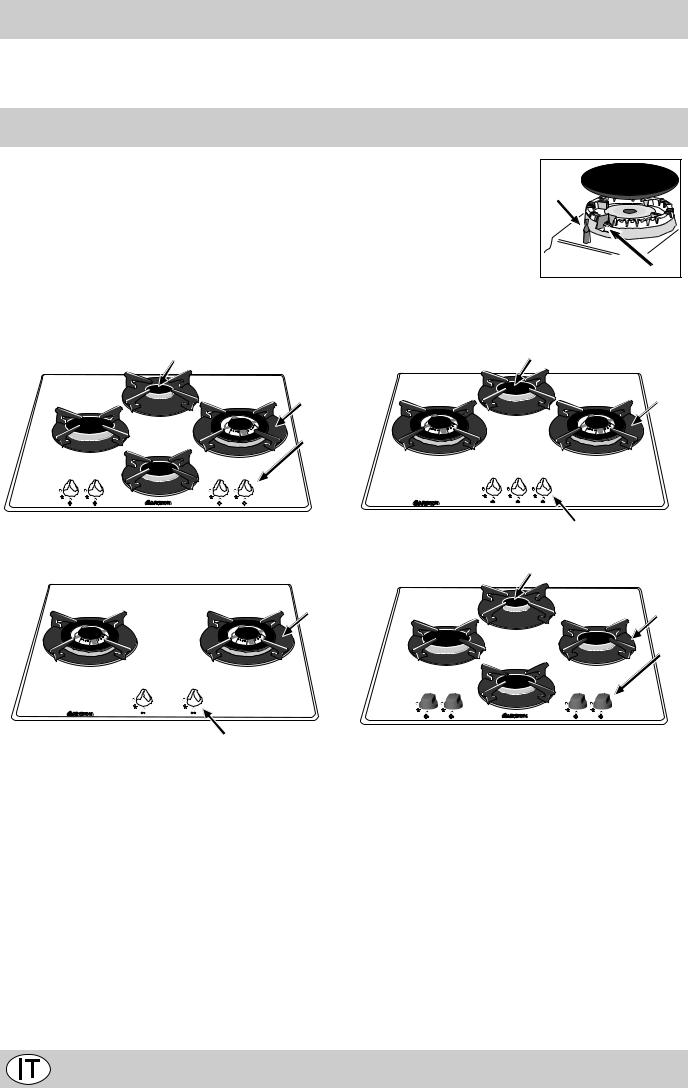
La ringraziamo per aver scelto un prodotto Ariston, sicuro e davvero facile da usare. Per conoscerlo, utilizzarlo al meglio e a lungo, le consigliamo di leggere questo manuale. Grazie
Visto da vicino
A.Bruciatori gas
B.Griglie di appoggio per recipienti di cottura
C.Manopole di comando dei bruciatori gas
D.Candela di accensione dei bruciatori gas (presente solo su alcuni modelli)
F.Dispositivo di sicurezza (presente solo su alcuni modelli) - Interviene in caso di spegnimento accidentale della fiamma (trabocco di liquidi, correnti d'aria, ...) bloccando l'erogazione del gas al bruciatore.
F |
D |
A
B C
A
B
C
A
A  B
B
B
C
C
2
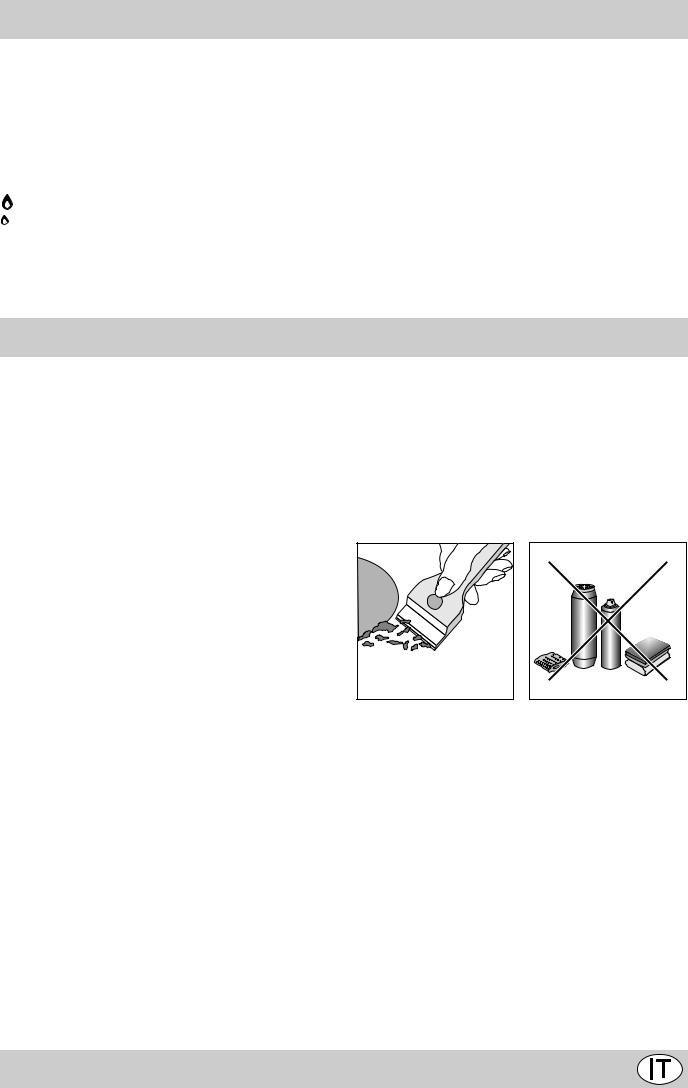
Come utilizzarlo
Su ciascuna manopola è indicata la posizione del bruciatore gas corrispondente.
Bruciatori gas
Sono di diverse dimensioni e potenze. Scegliete quello più adatto al diametro del recipiente da utilizzare.
Il bruciatore prescelto può essere regolato dalla manopola corrispondente come segue:
• Spento
Massimo
Minimo
Per accendere uno dei bruciatori, avvicinare allo stesso una fiamma o un accenditore, premere a fondo e ruotare la manopola corrispondente in senso antiorario fino alla posizione di massima potenza.
Nei modelli dotati di dispositivo di sicurezza "F", è necessario mantenere premuta la manopola per circa 6 secondi finchè non si scalda il dispositivo che mantiene automaticamente accesa la fiamma .
Nei modelli dotati di candela di accensione "D", per accendere il bruciatore prescelto è sufficiente prima premere a fondo la manopola corrispondente, poi ruotarla in senso antiorario fino alla posizione di massima potenza, tenendola premuta fino alla avvenuta accensione.
Avvertenza: nel caso di una estinzione accidentale delle fiamme del bruciatore, chiudere la manopola di comando e ritentare l’accensione dopo almeno 1 minuto.
Per spegnere il bruciatore occorre ruotare la manopola in senso orario fino all’arresto (corrispondente al simbolo “•”).
Come tenerlo in forma
Prima di ogni operazione disconnettere l'apparecchio dall' alimentazione elettrica.
Per una lunga durata del piano è indispensabile eseguire frequentemente una accurata pulizia generale, tenendo presente che:
•le parti smaltate ed in vetro vanno lavate con acqua tiepida senza usare polveri abrasive e sostanze corrosive che potrebbero rovinarli;
•gli elementi mobili dei bruciatori vanno lavati frequentemente con acqua calda e detersivo avendo cura di eliminare le eventuali incrostazioni;
•nei piani dotati di accensione automatica occorre procedere frequentemente ad una accurata pulizia della parte terminale dei dispositivi di accensione istantanea elettronica e verificare che i fori di uscita del gas non siano ostruiti;
•il piano va pulito con prodotti per la pulizia dei vetri. Evitare l'utilizzo di prodotti e pagliette abrasive che possono provocare rigature sul vetro.
•la superficie del piano dovrà essere pulita regolarmente con una soluzione di acqua tiepida e detergente non abrasivo. Dapprima togliere dal piano di cottura tutti i resti di vivande e spruzzi di grasso con un raschietto
per la pulizia per esempio 


 (non in dotazione) (Fig. A).
(non in dotazione) (Fig. A).
Pulire il piano di cottura quando è tiepido; utilizzare un prodotto di pulizia adatto, strofinare con un panno umido ed asciugare. Zucchero o vivande ad alto contenuto zuccherino vanno eliminati immediatamente dalla zona di cottura ancora calda con un raschietto. In nessun caso utilizzare spugne o prodotti abrasivi, anche detersivi chimicamente aggressivi come gli spray da forno o prodotti smacchianti vanno evitati (Fig. B);
Fig. A |
Fig. B |
Ingrassaggio dei rubinetti
Con il tempo può verificarsi il caso di un rubinetto che si blocchi o presenti difficoltà nella rotazione, pertanto sarà necessario provvedere alla pulizia interna e alla sostituzione del grasso.
N.B.: Questa operazione deve essere effettuata da un tecnico autorizzato dal costruttore.
3

Consigli d'uso
Consigli pratici per l’uso dei bruciatori
Al fine di ottenere il massimo rendimento è utile ricordare quanto segue:
•utilizzare recipienti adeguati a ciascun bruciatore (vedere tabella) al fine di evitare che le fiamme fuoriescano dal fondo dei recipienti.
•utilizzare sempre recipienti a fondo piatto e con coperchio.
•al momento dell’ebollizione ruotare la manopola fino alla posizione di minimo.
Bruciatore |
ø Diametro Recipienti(cm) |
|
|
Rapido (R) |
24 – 26 |
|
|
Rapido Ridotto (RR) |
22 – 24 |
|
|
Semi Rapido (S) |
16 – 20 |
|
|
Ausiliario (A) |
10 – 14 |
|
|
Tripla Corona (TC) |
24 – 26 |
|
|
Per identificare il tipo di bruciatore fate riferimento ai disegni presenti nel paragrafo "Caratteristiche dei bruciatori ed ugelli"
C'è qualche problema?
Può accadere che il piano non funzioni o non funzioni bene. Prima di chiamare l'assistenza, vediamo che cosa si può fare.
Innanzi tutto verificare che non ci siano interruzioni nelle reti di alimentazione gas ed elettrica, ed in particolare i rubinetti gas a monte del piano siano aperti.
Il bruciatore non si accende o la fiamma non è uniforme.
Avete controllato se:
•Sono ostruiti i fori di uscita del gas del bruciatore.
•Sono montate correttamente tutte le parti mobili che compongono il bruciatore.
•Ci sono correnti d'aria nelle vicinanze del piano.
La fiamma non rimane accesa nelle versioni con sicurezza.
Avete controllato se:
•Non avete premuto a fondo la manopola.
•Non avete mantenuto premuta a fondo la manopola per un tempo sufficiente ad attivare il dispositivo di sicurezza.
•Sono ostruiti i fori di fuoriuscita del gas in corrispondenza del dispositivo di sicurezza.
Il bruciatore in posizione di minimo non rimane acceso.
Avete controllato se:
•Sono ostruiti i fori di fuoriuscita del gas.
•Ci sono correnti d'aria nelle vicinanze del piano.
•La regolazione del minimo non è corretta (Vedi paragrafo "Regolazione minimi").
I recipienti sono instabili.
Avete controllato se:
•Il fondo del recipiente è perfettamente piano.
•Il recipiente è centrato sul bruciatore.
•Le griglie sono state invertite.
Se, nonostante tutti i controlli, il piano non funziona e l'inconveniente da voi rilevato persiste, chiamate il Centro Assistenza Tecnica Merloni Elettrodomestici più vicino, comunicando queste informazioni:
-Il tipo di guasto.
-La sigla del modello (Mod. ...) riportata sul certificato di garanzia.
Non ricorrete mai a tecnici non autorizzati e rifiutate sempre l'installazione di pezzi di ricambio non originali.
4

La sicurezza una buona abitudine
Per garantire l’efficienza e la sicurezza di questo elettrodomestico:
•rivolgetevi esclusivamente a centri di assistenza tecnica autorizzati
•richiedete sempre l’utilizzo di parti di ricambio originali
•Questo libretto riguarda un piano di cottura da incasso di classe3.
•L'apparecchio è concepito per uso non professionale nelle abitazioni e le sue caratteristiche non vanno modificate.
•Le istruzioni sono valide solo per i paesi di destinazione i cui simboli figurano sul libretto e sulla targa matricola.
•La sicurezza elettrica di questo apparecchio è assicurata soltanto quando lo stesso è correttamente collegato ad un efficiente impianto di messa a terra come previsto dalle vigenti norme di sicurezza.
Trattandosi di fonti di pericolo, evitare che bambini e incapaci abbiano contatti con:
-i comandi e l'apparecchio in genere;
-gli imballaggi (sacchetti, polistirolo, chiodi ecc.);
-l'apparecchio, durante e subito dopo il funzionamento, visto il surriscaldamento;
-l'apparecchio inutilizzato (in questo caso vanno rese innocue le parti che potrebbero essere pericolose).
Vanno evitate le seguenti operazioni:
-toccare l'apparecchio con parti del corpo umide;
-l'uso quando si è a piedi nudi;
-tirare l'apparecchio o il cavo di alimentazione per staccarli dalla presa di corrente;
-operazioni improprie e pericolose;
-ostruire le aperture di ventilazione o smaltimento calore;
-che il cavo di alimentazione di piccoli elettrodomestici finisca su parti calde dell'apparecchio;
-l'esposizione ad agenti atmosferici (pioggia, sole);
-l'utilizzo di liquidi infiammabili nei pressi;
-l'impiego di adattatori, prese multiple e/o prolunghe;
-l'impiego di pentole instabili o deformate;
-Il piano è resistente agli sbalzi di temperatura e agli urti. Tuttavia se colpito con oggetti come taglierini o utensili con bordi appuntiti può rompersi. In questo caso togliete subito l’alimentazione e rivolgetevi ad un centro di assistenza autorizzato.
-tentativi di installazione o riparazione senza l'intervento di personale qualificato.
Occorre assolutamente rivolgersi a personale qualificato nei seguenti casi:
-installazione (secondo le istruzioni del costruttore);
-quando si hanno dubbi sul funzionamento;
-sostituzione della presa in caso di incompatibilità con la spina dell'apparecchio.
Occorre rivolgersi a centri di assistenza autorizzati dal costruttore nei seguenti casi:
-in caso di dubbio sull'integrità dell'apparecchio dopo aver tolto l'imballaggio;
-danneggiamento o sostituzione del cavo di alimentazione;
-in caso di guasto o cattivo funzionamento, richiedendo i ricambi originali.
È opportuno effettuare le seguenti operazioni:
-solo la cottura dei cibi evitando altre operazioni;
-verificare l'integrità dopo aver tolto l'imballaggio;
-disconnettere l'apparecchio dalla rete di alimentazione elettrica in caso di cattivo funzionamento e prima di qualsiasi operazione di pulizia o manutenzione;
-quando inutilizzato, disinserire l'apparecchio dalla rete elettrica e chiudere il rubinetto del gas (se previsto);
-controllare sempre che le manopole siano nella posizione “•”/” o” quando l'apparecchio non è utilizzato;
-tagliare il cavo di alimentazione dopo averlo disconnesso dalla rete elettrica quando si decide di non utilizzare più l'apparecchio.
•Il costruttore non può essere considerato responsabile per eventuali danni derivanti da: errata installazione, usi impropri, erronei ed irragionevoli.
5
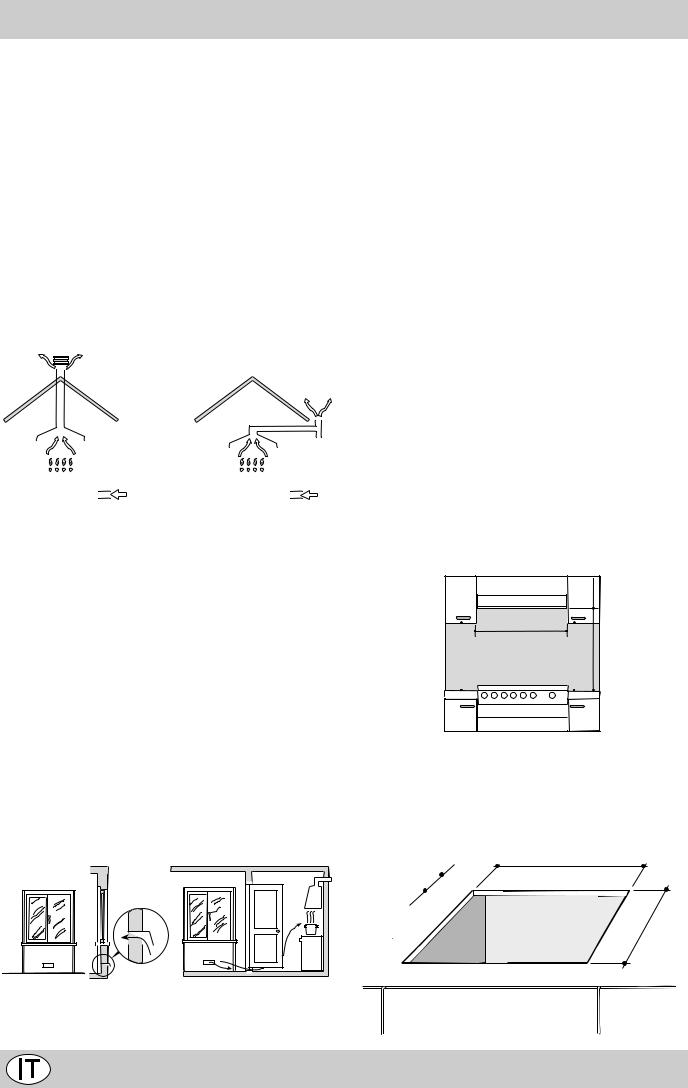
Installazione dei piani da incasso
Le istruzioni che seguono sono rivolte all’installatore qualificato affinchè compia le operazioni di installazione regolazione e manutenzione tecnica nel modo più corretto e secondo le norme in vigore.
Importante: qualsiasi intervento di regolazione, manutenzione etc. deve essere eseguito con il piano elettricamente disinserito.
Posizionamento
Importante: questo apparecchio può essere installato e funzionare solo in locali permanentemente ventilati secondo le prescrizioni delle Norme UNI-CIG 7129 e 7131 in vigore. Debbono essere osservati i seguenti requisiti:
a)Il locale deve prevedere un sistema di scarico all’esterno dei fumi della combustione, realizzato tramite una cappa o tramite un elettroventilatore che entri automaticamente in funzione ogni volta che si accende l’apparecchio.
|
|
|
|
|
|
|
|
|
|
|
|
|
|
|
|
|
|
|
|
|
|
|
|
|
|
|
|
|
|
|
|
|
|
|
|
|
|
|
|
|
|
|
|
|
|
|
|
|
|
|
|
|
|
|
|
|
|
|
|
|
|
|
|
|
|
|
|
|
|
|
|
|
|
|
|
|
|
|
|
|
|
|
|
|
|
|
|
|
|
|
|
|
|
|
|
|
|
|
|
|
|
|
|
|
|
|
|
|
|
|
|
|
|
|
|
|
|
|
|
|
|
|
|
|
|
|
|
|
|
|
|
|
|
|
|
|
|
|
|
|
|
|
|
|
|
|
|
|
|
|
|
|
|
|
|
|
|
|
|
|
|
|
|
|
|
|
|
|
|
|
|
|
|
|
|
|
|
|
|
|
|
|
|
|
|
|
|
|
|
|
|
|
|
|
|
|
|
|
|
|
|
|
|
|
|
|
|
|
|
|
|
|
|
|
|
|
|
|
|
|
|
|
|
|
|
|
|
|
|
|
|
|
|
|
|
|
|
|
|
|
|
|
|
|
|
|
|
|
|
|
|
In camino o in canna fumaria ramificata |
Direttamente all’esterno |
||||||||||||||||
(riservata agli apparecchi di cottura)
b)Il locale deve prevedere un sistema che consenta l’afflusso dell’aria necessaria alla regolare combustione. La portata di aria necessaria alla combustione non deve essere inferiore a 2 m³/h per kW di potenza installata. Il sistema può essere realizzato prelevando direttamente l’aria dall’esterno dell’edificio tramite un condotto di almeno 100 cm² di sezione utile e tale che non possa essere accidentalmente ostruito. Per gli apparecchi privi sul piano di lavoro, del dispositivo di sicurezza per assenza di fiamma, le aperture di ventilazione debbono essere maggiorate nella misura del 100%, con un minimo di 200cm² (Fig. A). Ovvero, in maniera indiretta da locali adiacenti, dotati di un condotto di ventilazione con l’esterno come sopra descritto, e che non siano parti comuni dell’immobile, o ambienti con peri-
colo di incendio, o camere da letto (Fig. B).
|
|
Particolare A |
|
|
|
|
Locale |
Locale da |
|||||||
|
|
|
|
|
|
|
|
|
|
|
|
adiacente |
ventilare |
||
|
|
|
|
|
|
|
|
|
|
|
|
|
|
|
|
|
|
|
|
|
|
|
|
|
|
|
|
|
|
|
|
|
|
|
|
|
|
|
|
|
|
|
|
|
|
|
|
|
|
|
|
|
|
|
|
|
|
|
|
|
|
|
|
|
|
|
|
|
|
|
|
|
|
|
|
|
|
|
|
|
|
|
|
|
|
|
|
|
|
|
|
|
|
|
|
|
|
|
|
|
|
|
|
|
|
|
|
|
|
|
|
A
|
|
|
|
|
|
|
|
|
|
|
|
|
|
|
|
|
|
|
|
|
|
|
|
Esempi di aperture di ventilazione |
Maggiorazione della fessura fra |
||||||
per l’aria comburente |
|
|
porta e pavimento |
||||
|
|
Fig. A |
|
|
Fig. B |
||
c)Un utilizzo intensivo e prolungato dell’apparecchio può necessitare di una aerazione supplementare per esempio l’apertura di una finestra o una aerazione più efficace aumentando la potenza di spirazione meccanica se essa esiste.
d)I gas di petrolio liquefatti, più pesanti dell’aria, ristagnano verso il basso. Quindi i locali contenenti bidoni di GPL debbono prevedere delle aperture verso l’esterno così da permettere l’evacuazione dal basso delle eventuali fughe di gas. Pertanto i bidoni di GPL, siano essi vuoti o parzialmente pieni, non debbono essere installati o depositati in locali o vani a livello più basso del suolo (cantinati, ecc.). É opportuno tenere nel locale solo il bidone in utilizzo, collocato in modo da non essere soggetto all’azione diretta di sorgenti di calore (forni, camini, stufe, ecc.) capaci di portarlo a temperature superiori ai 50°C.
Installazione dei piani da incasso
I piani a gas e misti sono predisposti con grado di protezione contro i riscaldamenti eccessivi di tipo X, è pertanto possibile l’installazione a fianco di mobili la cui altezza non superi quella del piano di lavoro. Per una corretta installazione del piano di cottura vanno osservate le seguenti precauzioni:
a)I mobili situati a fianco, la cui altezza superi quella del piano di lavoro, debbono essere situati ad almeno 600 mm. dal bordo del piano stesso.
b)Le cappe debbono essere installate secondo i requisiti richiesti nei libretti istruzioni delle cappe stesse, comunque ad una distanza minima di 650 mm.
c)Posizionare i pensili adiacenti alla cappa ad un’altezza minima dal top di 420 mm (Fig. C).
HOOD
|
Min. 600 mm. |
min. 650 mm. with hood min. 700 mm. without hood |
Min. 420 mm. |
Min. 420 mm. |
Fig. C
d)Allorchè il piano di cottura venga installato sotto un pensile, quest’ultimo dovrà mantenere una distanza minima dal top pari a 700 mm (millimetri) come da Fig. C.
e)Il vano del mobile dovrà avere le dimensioni indicate nella figura.
|
|
|
555 mm. |
|
|
|
|
|
|
|
|
|
. |
|
|
|
|
55 |
mm |
|
|
mm |
. |
|
|
||||
|
|
|
|||
|
|
475 |
|
||
|
|
|
|
||
|
|
|
|
|
|
|
|
|
|
|
|
6
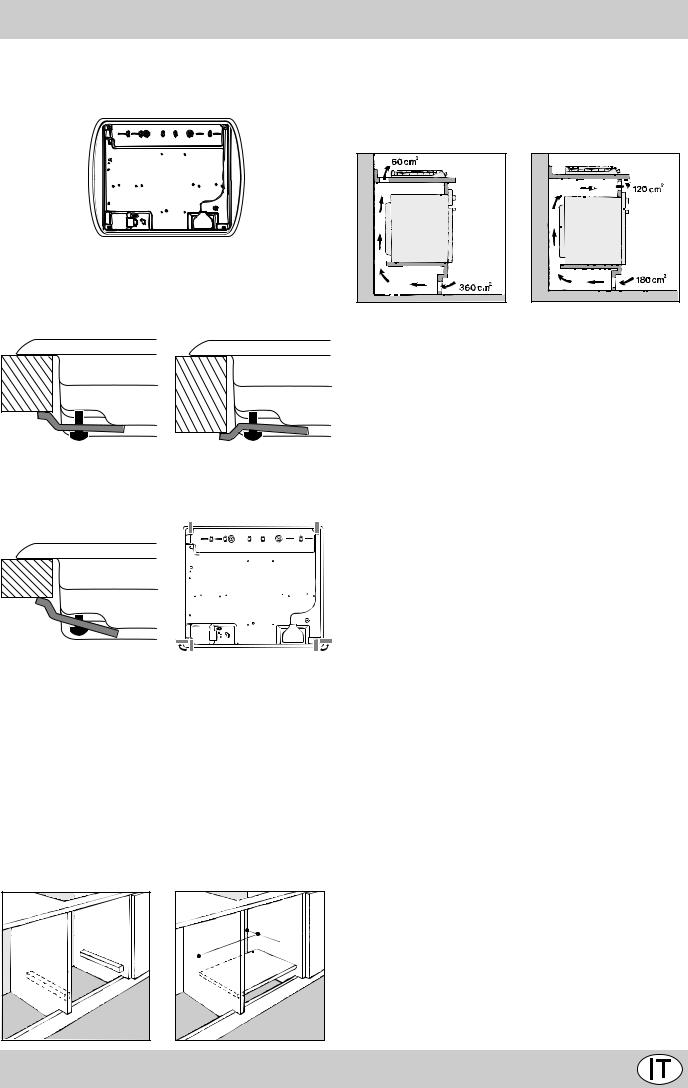
Prima di procedere al fissaggio al top, posizionare la guarnizione (in dotazione) lungo il perimetro del piano come rappresentato in figura.
Sono previsti dei ganci di fissaggio che consentono di fissare il piano su top da 20 a 40 mm. di spessore. Per un buon fissaggio del piano è consigliabile usare tutti i ganci a disposizione.
Schema di fissaggio dei ganci
Posizione gancio per |
Posizione gancio per |
top H=30mm |
top H=40mm |
|
Avanti |
Posizione gancio per |
Dietro |
top H=20mm |
|
N.B: Usare i ganci contenuti nella "confezione accessori"
f)Nel caso in cui il piano non sia installato su di un forno incasso, è necessario inserire un pannello di legno come isolamento. Esso dovrà essere posizionato ad una distanza minima di 20 mm. dalla parte inferiore del piano stesso.
Nota: Nel caso in cui il piano sia installato su di un forno incasso, è preferibile installare il forno in modo che appoggi su due listelli in legno; nel caso in cui sia presente un piano continuo di appoggio questo deve avere un’apertura posteriore di almeno 45 x 560 mm.
. |
45 |
mm. |
mm |
|
|
560 |
|
|
Nel caso di installazione sopra un forno da incasso senza ventilazione forzata di raffreddamento, per consentire un’adeguata areazione all’interno del mobile vanno garantite delle prese d’aria di ingresso e di uscita. Possibili esempi di montaggio sono illustrati nelle figure sottostanti.
Collegamento gas
Il collegamento dell’apparecchio alla tubazione o alla bombola del gas dovrà essere effettuato come prescritto dalle Norme UNI-CIG 7129 e 7131, solo dopo essersi accertati che esso è regolato per il tipo di gas con cui sarà alimentato. In caso contrario eseguire le operazioni indicate al paragrafo “Adattamento ai diversi tipi di gas”. Nel caso di alimentazione con gas liquido, da bombola, utilizzare regolatori di pressione conformi alle Norme UNI-CIG 7432.
Importante: per un sicuro funzionamento, per un adeguato uso dell’energia e maggiore durata dell’apparecchiatura, assicurarsi che la pressione di alimentazione rispetti i valori indicati nella tabella 1 “Caratteristiche dei bruciatori ed ugelli”.
Allaccio con tubo rigido (rame o acciaio)
L’allaccio all’impianto gas deve essere effettuato in modo da non provocare sollecitazioni di alcun genere all’apparecchio. Sulla rampa di alimentazione dell’apparecchio è presente un raccordo a “L” orientabile, la cui tenuta è assicurata da una guarnizione. Nel caso risulti necessario ruotare il raccordo sostituire tassativamente la guarnizione di tenuta (in dotazione con l’apparecchio). Il raccordo di entrata del gas all’apparecchio è filettato 1/2 gas maschio cilindrico.
Allaccio con tubo flessibile in acciaio inossidabile a parete continua con attacchi filettati
Il raccordo di entrata del gas all’apparecchio è filettato 1/ 2 gas maschio cilindrico. Utilizzare esclusivamente tubi conformi alla Norma UNI-CIG 9891 e guarnizioni di tenuta conformi alla UNI-CIG 9264. La messa in opera di tali tubi deve essere effettuata in modo che la loro lunghezza, in condizioni di massima estensione, non sia maggiore di 2000 mm. Ad allacciamento avvenuto assicurarsi che il tubo metallico flessibile non venga a contatto con parti mobili o schiacciato.
Controllo tenuta
Ad installazione ultimata controllare la perfetta tenuta di tutti i raccordi utilizzando una soluzione saponosa e mai una fiamma.
Collegamento elettrico
I piani dotati di cavo di alimentazione tripolare, sono predisposti per il funzionamento con corrente alternata alla tensione e frequenza di alimentazione indicate sulla targhetta caratteristiche (posta sulla parte inferiore del piano). Il conduttore di terra del cavo è contraddistinto dai
7
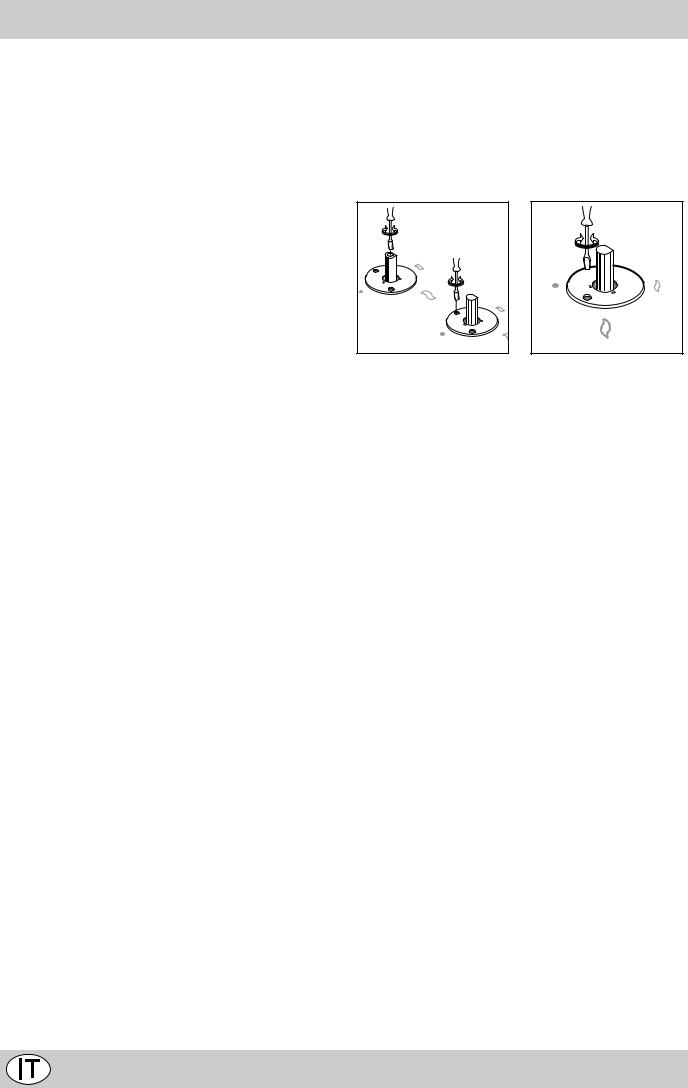
colori giallo-verde. Nel caso di installazione sopra un forno da incasso l’allaccio elettrico del piano e quello del forno deve essere realizzato separatamente, sia per ragioni di sicurezza elettrica che per facilitare l’eventuale estraibilità del forno.
Allacciamento del cavo di alimentazione alla rete
Montare sul cavo una spina normalizzata per il carico indicato sulla targhetta caratteristiche, nel caso di collegamento diretto alla rete è necessario interporre tra l’apparecchio e la rete un interruttore omnipolare con apertura minima fra i contatti di 3 mm. dimensionato al carico e rispondente alle norme in vigore (il filo di terra non deve essere interrotto dall’interruttore). Il cavo di alimentazione deve essere posizionato in modo che non raggiunga in nessun punto una temperatura superiore di 50°C a quella ambiente.
Prima di effettuare l’allacciamento accertarsi che:
•la valvola limitatrice e l’impianto domestico possano sopportare il carico dell’apparecchiatura (vedi targhetta caratteristiche);
•l’impianto di alimentazione sia munito di efficace collegamento a terra secondo le norme e le disposizioni di legge;
•la presa o l’interruttore omnipolare siano facilmente raggiungibili con il piano installato.
N.B: non utilizzare riduzioni, adattatori o derivatori in quanto essi potrebbero provocare riscaldamenti o bruciature.
Adattamento ai diversi tipi di gas
Per adattare il piano ad un tipo di gas diverso da quello per il quale esso è predisposto (indicato sulla etichetta fissata nella parte inferiore del piano o sull'imballo), occorre sostituire gli ugelli dei bruciatori effettuando le seguenti operazioni:
•togliere le griglie del piano e sfilare i bruciatori dalle loro sedi.
•svitare gli ugelli, servendosi di una chiave a tubo da 7mm. e sostituirli con quelli adatti al nuovo tipo di gas (vedi tabella 1 “Caratteristiche dei bruciatori ed ugelli”).
•rimontare le parti eseguendo all’inverso le operazioni.
•al termine dell’operazione, sostituite la vecchia etichetta taratura con quella corrispondente al nuovo gas d’utilizzo, reperibile presso i Nostri Centri Assistenza Tecnica.
Qualora la pressione del gas utilizzato sia diversa (o variabile) da quella prevista, è necessario installare, sulla tubazione di ingresso, un appropriato regolatore di pressione, secondo UNI-CIG 7430 (regolatori per gas canalizzati).
Regolazione aria primaria dei bruciatori
I bruciatori non necessitano di nessuna regolazione del- l’aria primaria.
8
Regolazione minimi
Regolazione minimi.
•portare il rubinetto sulla posizione di minimo;
•togliere la manopola ed agire sulla vite di regolazione posta all’interno o di fianco all’astina del rubinetto fino ad ottenere una piccola fiamma regolare;
N.B.: nel caso dei gas liquidi, la vite di regolazione dovrà essere avvitata a fondo.
•verificare che ruotando rapidamente la manopola dalla posizione di massimo a quella di minimo non si abbiano spegnimenti dei bruciatori.
•negli apparecchi provvisti del dispositivo di sicurezza (termocoppia), in caso di mancato funzionamento del dispositivo con bruciatori al minimo aumentare la portata dei minimi stessi agendo sulla vite di regolazione.
Effettuata la regolazione, ripristinate i sigilli posti sui bypass con ceralàcca o materiali equivalenti.
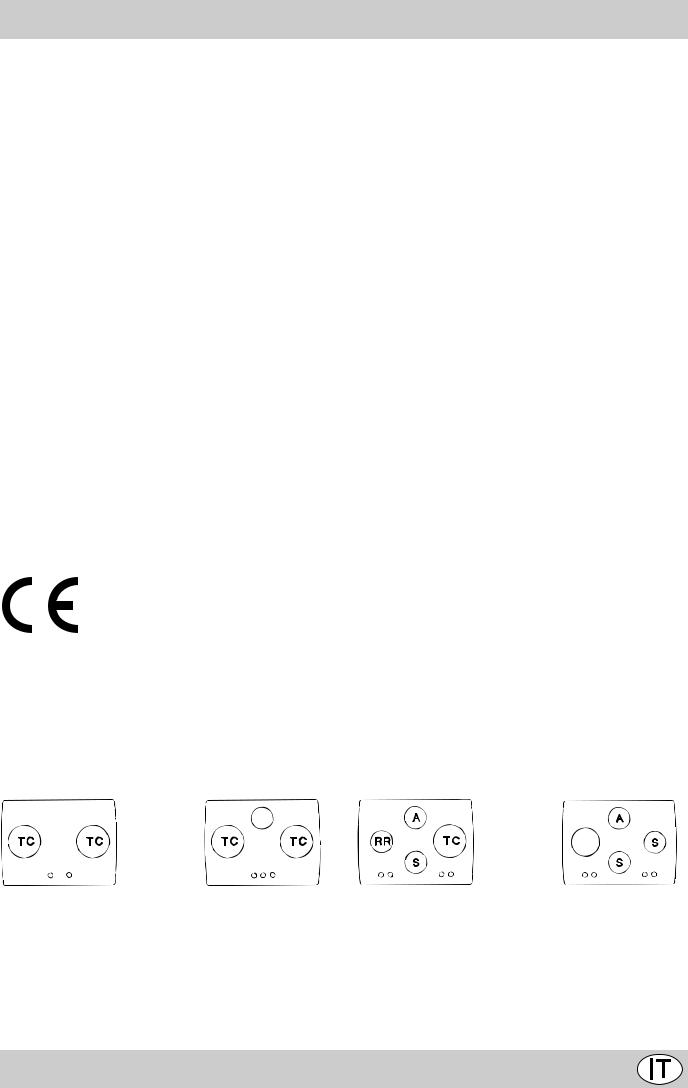
Caratteristiche dei bruciatori ed ugelli
Tabella 1 |
|
|
|
|
|
|
Gas liquido |
|
|
Gas naturale |
Gas città |
|||||
|
|
|
|
|
|
|
|
|
|
|
|
|
|
|
||
Bruciatore |
Diametro |
Potenza termica |
By-pass |
Ugello |
Portata * |
Ugello |
|
Portata * |
Ugello |
|
Portata * |
|||||
|
(mm) |
kW (p.c.s.*) |
1/100 |
1/100 |
|
g/h |
1/100 |
|
l/h |
1/100 |
|
l/h |
||||
|
|
|
|
|
(mm) |
|
|
|
|
|
|
|
|
|
|
|
|
|
|
|
|
|
|
|
|
|
|
|
|
|
|
|
|
|
|
Nomin. |
|
Ridot. |
|
(1) |
(mm) |
*** |
|
** |
(mm) |
|
|
(mm) |
|
|
|
|
|
|
|
|
|
|
|
|
|
|
|
|
|
|
|
Rapido |
100 |
3,00 |
|
0,70 |
41 |
39 |
86 |
218 |
|
214 |
116 |
|
286 |
285 |
|
680 |
(Grande) (R) |
|
|
|
|
||||||||||||
|
|
|
|
|
|
|
|
|
|
|
|
|
|
|
|
|
|
|
|
|
|
|
|
|
|
|
|
|
|
|
|
|
|
Rapido Ridotto |
100 |
2,60 |
|
0,7 |
41 |
39 |
80 |
189 |
|
186 |
110 |
|
248 |
260 |
|
592 |
(RR) |
|
|
|
|
||||||||||||
|
|
|
|
|
|
|
|
|
|
|
|
|
|
|
|
|
|
|
|
|
|
|
|
|
|
|
|
|
|
|
|
|
|
Semi Rapido |
75 |
1,65 |
|
0,4 |
30 |
28 |
64 |
120 |
|
118 |
96 |
|
157 |
185 |
|
374 |
(Medio) (S) |
|
|
|
|
||||||||||||
|
|
|
|
|
|
|
|
|
|
|
|
|
|
|
|
|
|
|
|
|
|
|
|
|
|
|
|
|
|
|
|
|
|
Ausiliario |
55 |
1,00 |
|
0,4 |
30 |
28 |
50 |
73 |
|
71 |
71 |
|
95 |
145 |
|
227 |
(Piccolo) (A) |
|
|
|
|
||||||||||||
|
|
|
|
|
|
|
|
|
|
|
|
|
|
|
|
|
|
|
|
|
|
|
|
|
|
|
|
|
|
|
|
|
|
Tripla Corona |
130 |
3,25 |
|
1,3 |
60 |
57 |
91 |
236 |
|
232 |
133 |
|
309 |
320 |
|
737 |
(TC) |
|
|
|
|
||||||||||||
|
|
|
|
|
|
|
|
|
|
|
|
|
|
|
|
|
|
|
|
|
|
|
|
|
|
|
|
|
|
|
|
|
|
Pressioni di |
Nominale (mbar) |
|
|
|
28-30 |
|
37 |
|
20 |
|
8 |
|||||
Minima (mbar) |
|
|
|
|
20 |
|
25 |
|
17 |
|
6 |
|||||
alimentazione |
|
|
|
|
|
|
|
|||||||||
Massima (mbar) |
|
|
|
35 |
|
45 |
|
25 |
|
15 |
||||||
|
|
|
|
|
|
|
||||||||||
|
|
|
|
|
|
|
|
|
|
|
|
|
|
|
|
|
*A 15°C e 1013 mbar-gas secco
** |
Propano |
P.C.S. = 50,37 MJ/kg |
*** |
Butano |
P.C.S. = 49,47 MJ/kg |
|
Naturale |
P.C.S. = 37,78 MJ/m3 |
|
Città |
P.C.S. = 15,87 MJ/m3 |
(1) Solo per apparecchi con dispositivo di sicurezza contro le fughe di gas (riferimento F).
Attenzione: Conformemente alla Direttiva CEE 90/396 l'adattabilità al Gas Città è consentita solo per apparecchi con dispositivo di sicurezza contro le fughe di gas (riferimento F).
Per la trasformazione a gas città, richiedere il kit ugelli presso un centro di assistenza Tecnica Merloni Elettrodomestici.
Questa apparecchiatura è conforme alle seguenti Direttive Comunitarie:
-73/23/CEE del 19/02/73 (Bassa Tensione) e successive modificazioni;
-89/336/CEE del 03/05/89 (Compatibilità Elettromagnetica) e successive modificazioni;
-90/396/CEE del 29/06/90 (Gas) e successive modificazioni;
-93/68/CEE del 22/07/93 e successive modificazioni.
TD 720... |
TD 730... |
TD 740... |
TO 740... |
S
R
9
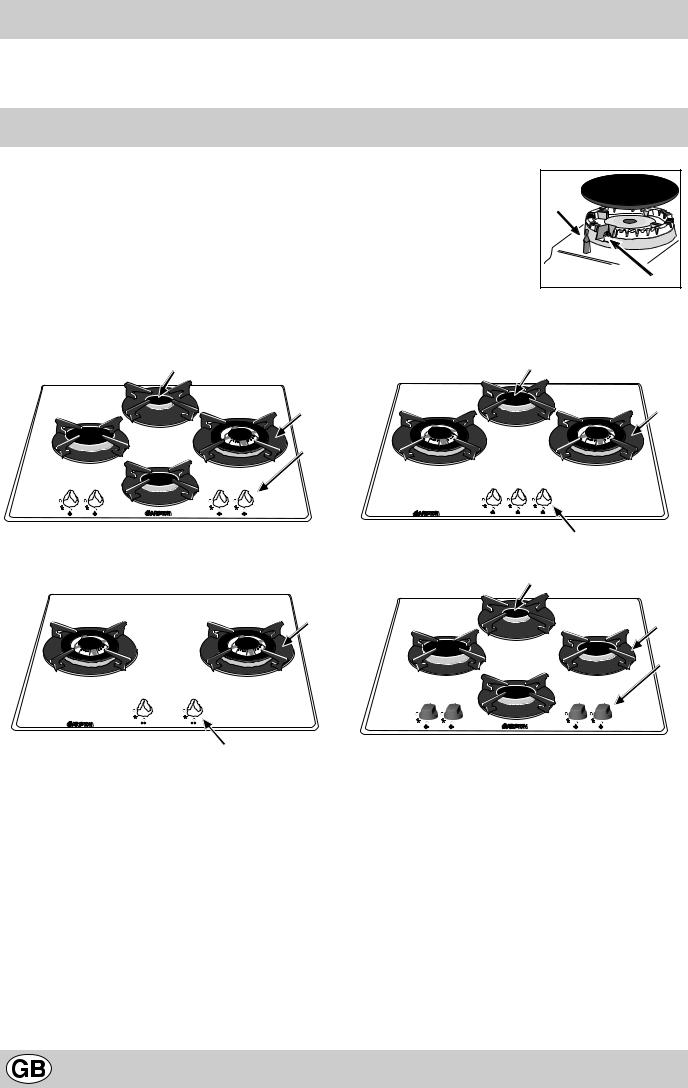
Congratualtions on choosing an Ariston appliance, which you will find is dependable and easy to use. We recommend that you read this manual for best performance and to extend the life of your appliance. Thank you.
Close-up View
A.Gas Burners
B.Support Grid for Cookware
C.Control Knobs for Gas Burners
D.Ignitor for Gas Burners (only on certain models)
F.Safety Device (only on certain models) - Activates if the flame accidentally goes out (spills, drafts, etc.), interrupting the delivery of gas to the burner.
F |
D |
A
B C
A
B
C
A
A  B
B
B
C
C
10

How To Use Your Appliance
The position of the corresponding gas burner is indicated on each control knob.
Gas Burners
The burners differ in size and power. Choose the most appropriate one for the diameter of the cookware being used.
The burner can be regulated with the corresonding control knob by using one of the following settings:
• Off
High
Low
To turn on one of the burners, place a lighted match or lighter near the burner, press the knob all the way in and turn in the counter-clockwise direction to the "High" setting.
On those models fitted with a safety device (F), the knob must be pressed in for about 6 seconds until the device that keeps the flame lighted warms up.
On those models fitted with an ignitor (D), to light a burner, simply press the corresponding knob all the way in and then turn it in the counter-clockwise direction to the "High" setting, keeping it pressed in until the burner lights. Caution: If the burner accidently goes out, turn off the gas with the control knob and try to light it again after waiting at least 1 minute.
To turn off a burner, turn the knob in the clockwise direction until it stops (it should be on the “•” setting).
How to Keep Your Cooktop in Shape
Before cleaning or performing maintenance on your appliance, disconnect it from the electrical power supply.
To extend the life of the cooktop, it is absolutely indispensable that it be cleaned carefully and thoroughly on a frequent basis, keeping in mind the following:
•Enameled and glass parts must be washed with lukewarm water without using abrasive powders or corrosive substances that could damage them;
•The removable parts of the burners should be washed frequently with warm water and soap, making sure to remove caked-on substances;
•On cooktops with automatic ignition, the end of the electronic ignition device must be cleaned carefully and frequently, making sure that the gas holes are not clogged;
•the top must be cleaned with glass cleaning products. Avoid using abrasive products and abrasive sponges that could scratch the glass.
•the glass surface should be cleaned regularly with a soultion of warm water and a non-abrasive detergent. First, remove all food buildup or grease with a cleaning
scraper, e.g. 


 (not supplied) (Fig. A). Clean the cooking surface when it is still warm with a suitable cleaning product, then rub with a damp cloth and dry. Sugar or foods with a high sugar content that have melted onto the surface must be removed immediatley with a scraper while the cooking surface is still hot. Do not use abrasive sponges or cleaning products under any circumstances. This holds true for chemically aggressive cleaners, like oven sprays and stain removers (Fig. B);
(not supplied) (Fig. A). Clean the cooking surface when it is still warm with a suitable cleaning product, then rub with a damp cloth and dry. Sugar or foods with a high sugar content that have melted onto the surface must be removed immediatley with a scraper while the cooking surface is still hot. Do not use abrasive sponges or cleaning products under any circumstances. This holds true for chemically aggressive cleaners, like oven sprays and stain removers (Fig. B);
Fig. A |
Fig. B |
Do not place anything, e.g. flame tamer, asbestos mat, between pan and pan support as serious damage to the appliance may result.
Do not remove the pan support and enclose the burner with a work stand as this will concentrate and deflect the heat onto the hotplate.
Do not use large pots or heavy weights which can bend the pan support or deflect the flame onto the hotplate.
Greasing the Gas Valves
Over time, the gas valves may stick or become difficult to turn. If this is the case, the must be cleaned on the inside and the regreased.
N.B.: This procedure must be performed by a technician authorized by the manufacturer.
11

Practical Advice
Practical Advise on Using the Burners
For best performance, follow these general guidelines:
•Use the appropriate cookware for each burner (see table) in order to prevent the flame from reaching the sides of the pot or pan;
•Alwasy use cookware with a flat bottom and keep the lid on;
•When the contents come to a boil, turn the knob to "Low".
Burner |
ø Cookware Diameter (cm) |
|
|
Fast (R) |
24 – 26 |
|
|
Reduced Fast (RR) |
22 – 24 |
|
|
Semi Fast (S) |
16 – 20 |
|
|
Auxiliary (A) |
10 – 14 |
|
|
Triple Crown (TC) |
24 – 26 |
|
|
To identify the type of burner, refer to the designs in the section entitled, "Burner and Nozzle Specifications".
Is there a problem?
It may occur that the cooktop does not function or does not function properly. Before calling customer service for assistance, lets see what can be done.
First of all, check to see that there are no interruptions in the gas and electrical supplies, and, in particular, that the gas valves for the mains are open.
The burner does not light or the flame is not uniform around the burner.
Check to make sure that:
•The gas holes on the burner are not clogged;
•All of the movable parts that make up the burner are mounted correctly;
•There are no draughts around the cooking surface.
The flame does not stay lighted on the model with the safety device.
Check to make sure that:
•You press the knob all the way in;
•You keep the knob pressed in long enough to activate the safety device.
•The gas holes are not clogged in the area corresponding to the safety device.
The burner does not remain on when set to "Low".
Check to make sure that:
•The gas holes are not clogged.
•There are no draughts near the cooking surface.
•The minimum has been adjusted correctly (see the section entitled, "Minimum Regulation").
The cookware is not stable.
Check to make sure that:
•The bottom of the cookware is perfectly flat.
•The cookware is centered correctly on the burner.
•The support grids have not been inverted.
If, despite all of these checks, the cooktop does not function properly and problem persists, call the nearest Merloni Elettrodomestici Customer Service Centre, informing them of:
-The type of problem.
-The abbreviation used to identify the model (Mod. ...) as indicated on the warranty.
Never call upon technicians not authorized by the manufacturer, and refuse to accept spare parts that are not original.
12

Safety Is a Good Habit to Get Into
To maintain the EFFICIENCY and SAFETY of this appliance, we recommend:
•call only the Service Centers authorized by the manufacturer
•always use original Spare Parts
•This manual is for a class 3 built-in cooktop.
•This appliance is designed for non-professional use in the home and its features and technical characteristics must not be modified.
•These instructions are only valid for the countries the symbols for which appear on the manual and the serial plate.
•The electrical system of this appliance is safe only when it is correctly connected to an adequate earthing system, as required by current safety standards.
Prevent children and the disabled from coming into contact or having access to the following, as they are possible sources of danger:
-The controls and the appliance in general;
-The packaging (plastic bags, polystyrene, nails, etc.);
-The appliance, during and immediately after use given the heat generated by its use;
-The appliance when no longer in installed (in this case, all potentially dangerous parts must be made safe).
The following should be avoided:
-Touching the appliance with wet parts of the body;
-Using the appliance with bare feet;
-Pulling on the appliance or the power supply cord to disconnect them from the electrical outlet;
-Improper and/or dangerous use;
-Obstructing the ventilation or heat dissipation slots;
-Allowing the power supply cord of small appliances to come into contact with the hot parts of the cooktop;
-Exposure to atmospheric agents (rain, sun);
-Using flammable liquids nearby;
-Using adaptors, multiple outlet plugs and/or extensions;
-Using unstable or deformed cookware;
-The top made is resistant to sudden temperature changes and shocks. However, if it is struck with pointed utensils or objects such as cutting knives, it may crack or break. If this occurs, disconnect the appliance immediately from the power supply
and contact an authorised service centre.
-Trying to install or repair the appliance without the assistance of qualified personnel.
The assistance of qualified personnel must be called upon in the following cases:
-Installation (in accordance with the manufacturer's instructions);
-When in doubt about the operation of the appliance;
-Replacement of the electrical outlet becuase it is incompatible with the plug.
Contact service centers authorized by the manufacturer in the following cases:
-When in doubt about the condition of the appliance after having removed the packing;
-Damage to or replacement of the power supply cord;
-In the case of a breakdown or malfunction: ask for original spare parts.
It is recommended that you follow the guidelines below:
-Only use the appliance to cook food, avoiding all other uses;
-Check the condition of the appliance after it has been unpacked;
-Disconnect the appliance from the power supply in the event of malfunction and always before cleaning or maintenance;
-When not in use, disconnect the appliance from the power supply and turn off the gas valve (if present);
-Always check to make sure that the control knobs are on the “•”/” o” setting when the appliance is not in use;
-Cut the power supply cord after disconnecting it from the electrical mains when you decide to no longer use the appliance.
•The manufacturer will not be held liable for any damages arising out of : incorrect installation or improper, incorrect or unreasonable use..
13
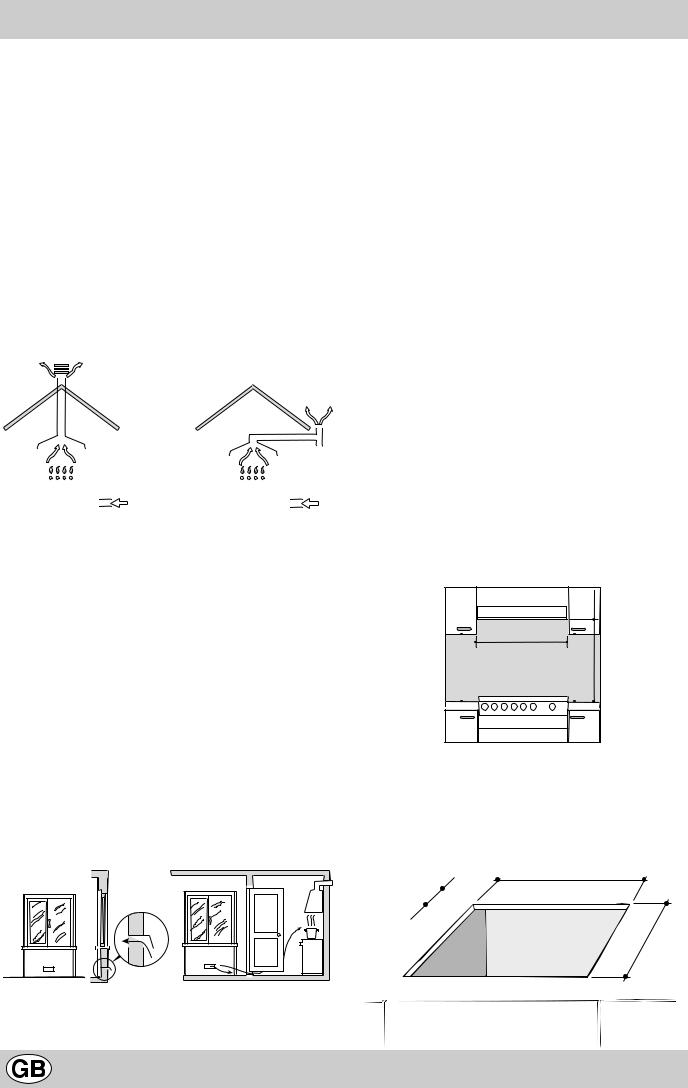
Installation Instructions for built-in
The following instructions are intended for the installer so that the installation and maintenance procedures may be followed in the most professional and expert manner possible. Important: Disconnect the appliance from the electrical supply before performing any maintenance or regulation upkeep work.
Positioning the Cooktop
Important: this unit may be installed and used only in permanently ventilated rooms in accordance with British Standard Codes Of Practice: B.S. 6172 / B.S. 5440, Par. 2 and B.S. 6891 Current Editions. The following requirements must be observed:
a)The room must be fitted with a ventilation system which vents smoke and gases from combustion to the outside. This must be done by means of a hood or electric ventilator that turns on automatically each time the hood is operated.
|
|
|
|
|
|
|
|
|
|
|
|
|
|
|
|
|
|
|
|
|
|
|
|
|
|
|
|
|
|
|
|
|
|
|
|
|
|
|
|
|
|
|
|
|
|
|
|
|
|
|
|
|
|
|
|
|
|
|
|
|
|
|
|
|
|
|
|
|
|
|
|
|
|
|
|
|
|
|
|
|
|
|
|
|
|
|
|
|
|
|
|
|
|
|
|
|
|
|
|
|
|
|
|
|
|
|
|
|
|
|
|
|
|
|
|
|
|
|
|
|
|
|
|
|
|
|
|
|
|
|
|
|
|
|
|
|
|
|
|
|
|
|
|
|
|
|
|
|
|
|
|
|
|
|
|
|
|
|
|
|
|
|
|
|
|
|
|
|
|
|
|
|
|
|
|
|
|
|
|
|
|
|
|
|
|
|
|
|
|
|
|
|
|
|
|
|
|
|
|
|
|
|
|
|
|
|
|
In a chimney stack or branched flue. |
Directly to the Outside |
|
|||||||||||||
(exclusively for cooking appliances)
b)The room must also allow for the influx of the air needed for proper combustion. The flow of air for combustion purposes must not be less than 2 m³/h per kW of installed capacity.The supply of said air can be effected by means of direct influx from the outside through a duct with a inner cross section of at least 100 cm² which must not be able to be accidentally blocked.Those appliances which are not fitted with a safety device to prevent the flame from accidentally going out must have a ventilation opening twice the size otherwise required, i.e. a minimum of 200cm² (Fig. A). Otherwise, the room can be vented indirectly through adjacent rooms fitted with ventilation ducts to the outside as described above, as long as the adjacent rooms are not shared areas, bedrooms or
present the risk of fire (Fig. B).
|
|
Detail A |
|
|
|
|
|
|
Adjacent |
Room to be |
|||||
|
|
|
|
|
|
|
|
|
|
|
|
Room |
Vented |
||
|
|
|
|
|
|
|
|
|
|
|
|
|
|
|
|
|
|
|
|
|
|
|
|
|
|
|
|
|
|
|
|
|
|
|
|
|
|
|
|
|
|
|
|
|
|
|
|
|
|
|
|
|
|
|
|
|
|
|
|
|
|
|
|
|
|
|
|
|
|
|
|
|
|
|
|
|
|
|
|
|
|
|
|
|
|
|
|
|
|
|
|
|
|
|
|
|
|
|
|
|
|
|
|
|
|
|
|
|
|
|
|
A
|
|
|
|
|
|
|
|
|
|
|
|
|
|
|
|
|
|
|
|
|
|
|
|
Examples of ventilation holes |
Enlarging the ventilation slot |
||||||
|
for comburant air. |
between window and floor. |
|||||
|
|
Fig. A |
|
|
Fig. B |
||
c)Intensive and prolonged use of the appliance may necessitate supplemental ventilation, e.g.opening a window or increasing the power of the air intake system (if present).
d)Liquidified petroleum gases are heavier than air and, as a result, settle downwards. Rooms in which LPG tanks are installed must be fitted with ventilation openings to the outside in order to allow the gas to escape in the event of a leak.Therefore, LPG tanks, whether empty or partially full, must not be installed or stored in rooms or spaces below ground level (cellars, ect.).It is also a good idea to keep only the tank currently being used in the room, making sure that it is not near sources of heat (ovens, fireplaces, stoves, etc.) that could raise the internal temperature of the tank above 50°C.
Installation of Built-in Cooktops
The gas cooktops are equipped with type X degree protection against overheating. Therefore, the appliance can be installed next to cabinets, provided the height of the cabinet does not exceed that of the hob. For proper installation of the cooktop, the following guidlines must be followed:
a)If the cabinet(s) located next to the cooktop are higher than the cooktop itself, the cabinet(s) must be installed at least 600 mm from the edge cooktop;
b)Hoods must be installed in accordance with the instructions contained in the installation manual for the hoods themselves, and no less than 650 mm from the cooktop;
c)The cabinets installed next to the hood must be located at a height of at least 420 mm from the top, (as shown in Fig. C).
HOOD
|
Min. 600 mm. |
min. 650 mm. with hood min. 700 mm. without hood |
Min. 420 mm. |
Min. 420 mm. |
Fig. C
d)Should the cooktop be installed directly under a cupboard, the latter should be at least 700 mm (millimetres) from the top, as shown in Fig. C.
e)The dimensions of the cutout for the appliance must be those indicated in the figure.
|
|
|
555 mm. |
|
|
|
|
|
|
|
|
|
. |
|
|
|
|
55 |
mm |
|
|
mm |
. |
|
|
||||
|
|
|
|||
|
|
475 |
|
||
|
|
|
|
||
|
|
|
|
|
|
|
|
|
|
|
|
14
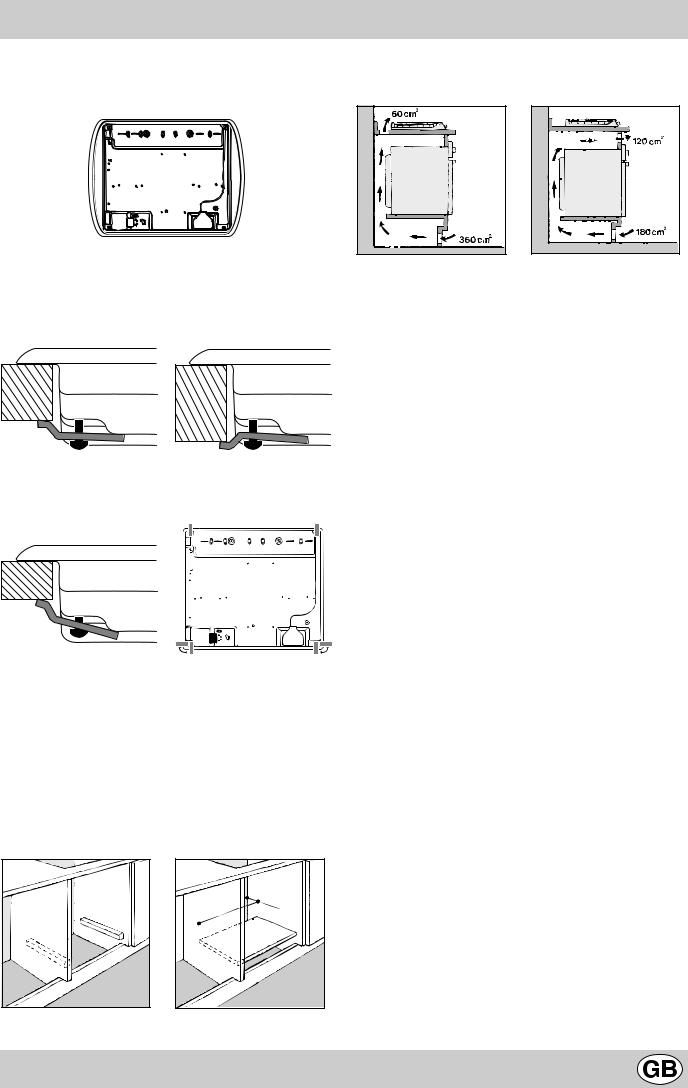
Before fastening the cooktop in place, position the seal (supplied) along the perimeter of the countertop, as shown in the figure.
Clamps are provided to fasten the cooktop to counters measuring from 20 to 40 mm in thickness. To fasten the cooktop securely, it is recommended that all the clamps be used.
Fastening Clamps - Assembly Diagram
Clamp Position for |
Clamp Position for |
||
H=30mm top |
H=40mm top |
||
|
|
|
Front |
|
|
|
|
|
|
|
|
Clamp Position for
H=20mm top Back
N.B: Use the clamps contained in the "accessory kit."
f)In the event the cooktop is not installed above a builtin oven, a wood panel must be inserted as insulation. This panel must be placed at least 20 mm from the
bottom of the cooktop itself.
Important: When installing the cooktop above a built-in oven, the oven should be placed on two wooden strips; in the case of a joining cabinet surface, remember to leave a space of at least 45 x 560 mm at the back.
. |
45 |
mm. |
mm |
|
|
560 |
|
|
When installing the cooktop above a built-in oven without forced ventilation, ensure that there are air inlets and outlets for ventilating the interior of the cabinet adequately.
Gas Connection for Cooktop
The cooktop should be connected to the gas supply by an authorized installer. During installation of this product it is essential to fit an approved gas tap to isolate the supply from the appliance for the convenience of any subsequent removal or servicing. Connection of the appliance to the gas mains or liquid gas tanks must be carried out according to the safety standards currently in force, and only after it is ascertained that it is suitable for the type of gas to be used. If not, follow the instructions indicated in the section entitled, “Adapting the Cooktop for Different Types of Gas”. If the cooktop is to be connected to tanks containing liquid gas, use pressure regulators that comply with current safety standards.
Important: To insure that the appliance operates safety, the gas is regulated correctly and your appliance lasts over time, make sure that gas pressure levels comply with the indications given in Table 1, “Nozzle and Burner Specifications”.
Gas Connection to Non-flexible Pipe
(copper or steel)
Connection to the gas source must be done in such a way as to not create any stress points at any part of the appliance.
The appliance is fitted with an adjustable, "L" shaped connector and a gasket for the attachment to the gas supply. Should this connector have to be turned, the gasket must be replaced (supplied with the appliance).
The gas feed connector to the appliance is a threaded, male 1/2" connector for round gas pipe.
Gas Connection to Flexible Steel Pipe
The gas feed connector to the appliance is a threaded, male 1/2" connector for round gas pipe. Only use pipes, tubes and gaskets that comply with current safety codes. The maximum length of the flexible pipes must not exceed 2000 mm. Once the connection has been made, ensure that the flexible metal tube does not touch any moving parts and is not crushed.
Check the Seal
Once the appliance has been installed, make sure all the connections are properly sealed, using a soapy water solution. Never use a flame.
Electrical Connection
The cooktops fitted with a tripolar electrical supply cord are designed to be be used with alternating current according to the indications on the rating plate located under the cooktop. The earthing wire can be identified by
15
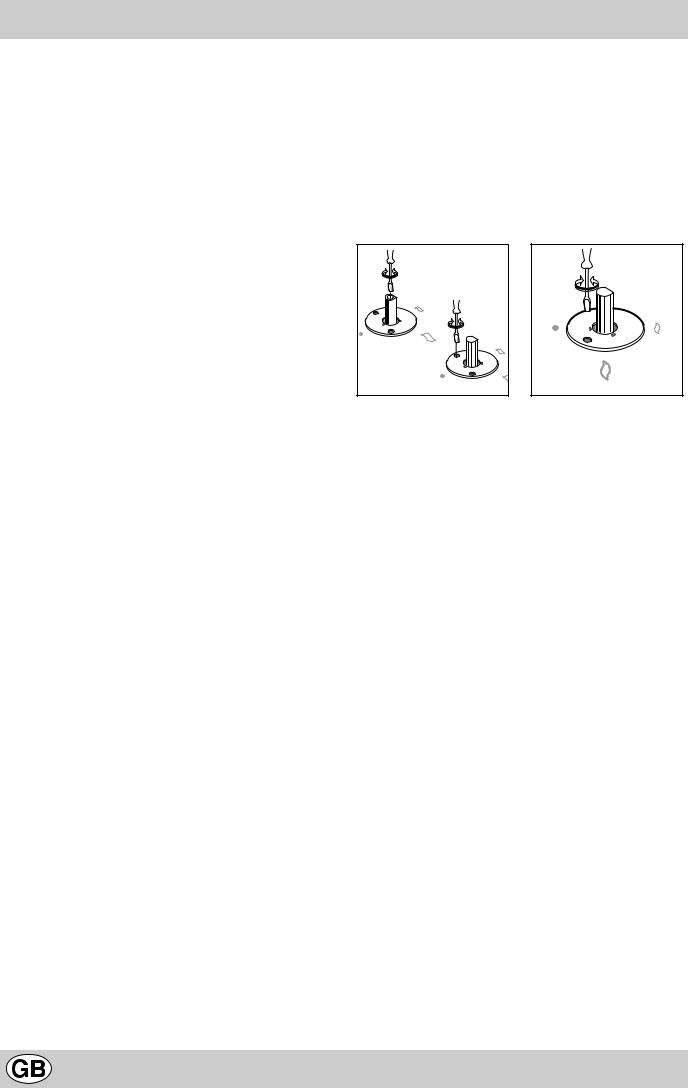
its yellow-green colour.
In the case of installation over a built-in electric oven, the electrical connections for the cooktop and oven should be independent, not only for safety purposes, but also to facilitate removal of one or both in the future.
Electrical Connection for Gas Cooktop
Fit the supply cord with a standard plug for the demand rate indicated on the rating plate or connect it directly to the electrical mains. In the latter case, a single pole switch must be placed between the appliance and the mains, with a minimum opening between the contacts of 3 mm in compliance with current safety codes (the earthing wire must not be interrupted by the switch). The power supply cord must be positioned so that it does not reach a temperature in excess of 50°C above room temperature at any point.
Before making the actual connection, make sure that:
•The fuse and electrical system can withstand the load required by the appliance;
•That the electrical supply system is equiped with an efficient earth hook-up according to the norms and regulations prescribed by law;
•That the plug or switch is easily accessible. Important: the wires in the mains lead are coloured in accordance with the following code:
Green & Yellow |
- Earth |
Blue |
- Neutral |
Brown |
- Live |
As the colours of the wires in the mains lead may not correspond with the coloured markings identifying the terminals in your plug, proceed as follows:
Connect the Green & Yellow wire to the terminal marked “E” or  or coloured Green or Green & Yellow. Connect the Brown wire to the terminal marked “L” or coloured Red.
or coloured Green or Green & Yellow. Connect the Brown wire to the terminal marked “L” or coloured Red.
Connect the Blue wire to the terminal marked “N” or coloured Black.
Adapting the Cooktop for Different Types of Gas
To adapt the cooktop to a different type of gas than that for which it was designed, (see the sticker under the hob or on the packaging), the burner nozzles must be changed, as follows:
•Remove the pan supports and slide the burners out of the cooktop.
•Unscrew the nozzles using a 7mm socket wrench and replace them with those for the new type of gas. (See table 1, “Burner and Nozzle Specifications”).
•Reassemble the parts following the instructions in reverse order.
•On completing the operation, replace the old rating label
with the one showing the new type of gas; the sticker is available from our Service Centres.
If the gas pressure is different than that prescribed, a pressure regulator must be installed at the source, in compliance with national standards governing the use of piped gas regulators.
Regulation of Air Supply to the Burner
The burners do not need a primary air regulator.
Minimum Regulation
Minimum regulation.
•Turn the gas valve to minimum.
•Remove the knob and turn the regulator screw (positioned either on the side of the top or inside the shaft) clockwise until the flame becomes small but regular.
N.B.: In the case of liquid gas, the regulation screw must be fully screwed in (clockwise).
•Make sure that, when the knob is turned rapidly high to low, the flame does not go out.
•In the event of a malfunction on appliances with the
security device (thermocouple) when the gas supply is set at minimum, increase the minimum supply levels using the regulator screw.
Once the adjustment has been made, apply sealing wax, or a suitable substitute, to the old seals on the by-pass.
16
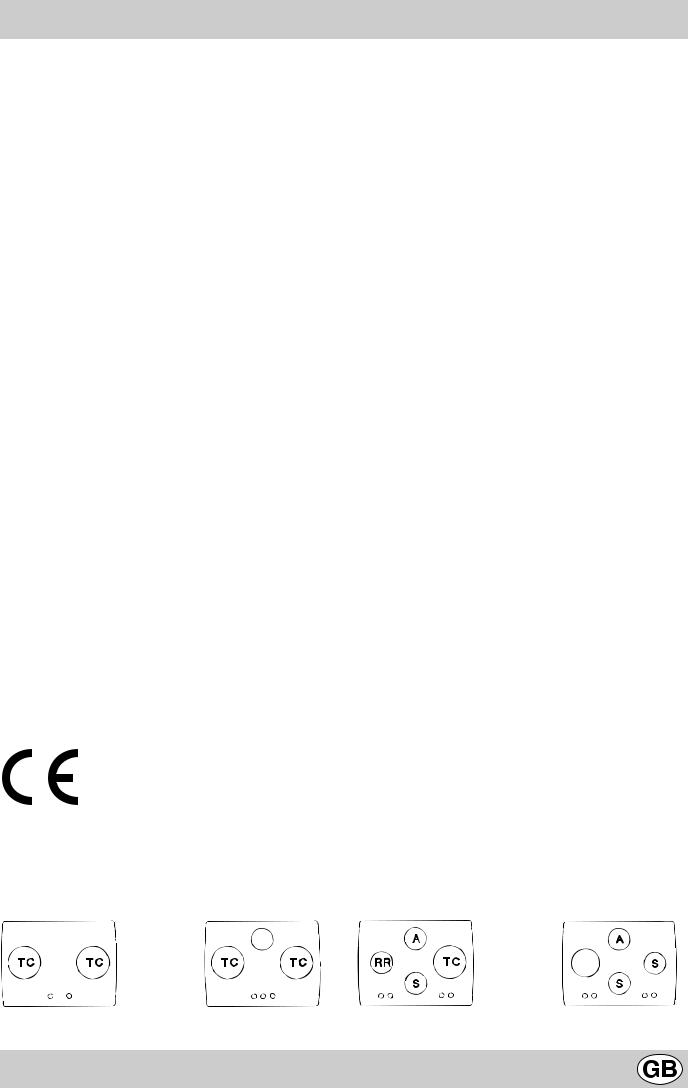
Burners and Nozzle Specifications
Table 1 |
|
|
|
|
|
|
|
Liquid gas |
|
|
|
Natural gas |
||||
|
|
|
|
|
|
|
|
|
|
|
|
|
|
|||
Burner |
Diameter |
Thermal power |
By-pass |
|
Nozzle |
|
Flow* |
Nozzler |
|
Flow* |
||||||
|
(mm) |
kW (p.c.s.*) |
|
1/100 |
|
1/100 |
|
|
g/h |
1/100 |
|
l/h |
||||
|
|
|
|
|
|
(mm) |
|
|
|
|
|
|
|
|
|
|
|
|
|
|
|
|
|
|
|
|
|
|
|
|
|
|
|
|
|
Nom. |
|
Red. |
|
|
(1) |
|
(mm) |
|
*** |
|
** |
(mm) |
|
|
|
|
|
|
|
|
|
|
|
|
|
|
|
|
|
|
|
Fast |
100 |
3.00 |
|
0.7 |
41 |
|
39 |
|
86 |
|
218 |
|
214 |
116 |
|
286 |
(Large) (R) |
|
|
|
|
|
|
||||||||||
|
|
|
|
|
|
|
|
|
|
|
|
|
|
|
|
|
|
|
|
|
|
|
|
|
|
|
|
|
|
|
|
|
|
Reduced Fast |
100 |
2.60 |
|
0.7 |
41 |
|
39 |
|
80 |
|
189 |
|
186 |
110 |
|
248 |
(RR) |
|
|
|
|
|
|
||||||||||
|
|
|
|
|
|
|
|
|
|
|
|
|
|
|
|
|
|
|
|
|
|
|
|
|
|
|
|
|
|
|
|
|
|
Semi Fast |
75 |
1.65 |
|
0.4 |
30 |
|
28 |
|
64 |
|
120 |
|
118 |
96 |
|
157 |
(Medium) (S) |
|
|
|
|
|
|
||||||||||
|
|
|
|
|
|
|
|
|
|
|
|
|
|
|
|
|
|
|
|
|
|
|
|
|
|
|
|
|
|
|
|
|
|
Auxiliary |
55 |
1.00 |
|
0.4 |
30 |
|
28 |
|
50 |
|
73 |
|
71 |
71 |
|
95 |
(Small) (A) |
|
|
|
|
|
|
||||||||||
|
|
|
|
|
|
|
|
|
|
|
|
|
|
|
|
|
|
|
|
|
|
|
|
|
|
|
|
|
|
|
|
|
|
Triple Crown (TC) |
130 |
3.25 |
|
1.3 |
60 |
|
57 |
|
91 |
|
236 |
|
232 |
133 |
|
309 |
|
|
|
|
|
|
|
|
|
|
|
|
|
|
|
|
|
|
Nominal (mbar) |
|
|
|
|
|
|
|
28-30 |
|
37 |
20 |
|
|||
Supply pressures |
Minimum (mbar) |
|
|
|
|
|
|
20 |
|
25 |
17 |
|
||||
|
Maximum (mbar) |
|
|
|
|
|
|
35 |
|
45 |
25 |
|
||||
|
|
|
|
|
|
|
|
|
|
|
|
|
|
|
|
|
*At 15°C and 1013 mbar-dry gas
** |
Propane |
|
P.C.S. = 50.37 MJ/kg. |
|
|
|
|
|
|
|
||
*** |
Butane |
|
P.C.S. = 49.47 MJ/kg. |
|
|
|
|
|
|
|
||
|
Natural |
|
P.C.S. = 37.78 MJ/m3 |
|
|
|
|
|
|
|
||
(1) Only for appliances with the security device (Ref. F). |
|
|
|
|
|
|
||||||
Table1 (For Hungary) |
|
|
|
|
|
|
|
|
|
|||
|
G 20 |
G 25.1 |
|
G 30 |
||||||||
(only model TD 740 MST) |
|
|||||||||||
|
|
|
|
|
|
|
|
|||||
|
|
|
|
|
|
|
|
|
|
|
|
|
Burner |
|
|
By-pass |
Thermal |
Nozzle |
Thermal |
|
Nozzle |
|
Thermal |
Nozzle |
|
|
|
|
|
1/100 (mm) |
power kW |
1/100 (mm) |
power kW |
|
1/100 (mm) |
|
power kW |
1/100 (mm) |
Triple Crown (TC) |
|
57 |
3,00 |
133 |
2,40 |
|
133 |
|
2,70 |
91 |
||
|
|
|
|
|
|
|
|
|
|
|||
Reduced Fast (RR) |
39 |
2,60 |
110 |
2,00 |
|
110 |
|
2,30 |
80 |
|||
|
|
|
|
|
|
|
|
|
|
|
|
|
Semi Fast (S) |
|
|
28 |
1,65 |
96 |
1,25 |
|
96 |
|
1,40 |
64 |
|
|
|
|
|
|
|
|
|
|
|
|
|
|
Auxiliary (A) |
|
|
28 |
1,00 |
71 |
0,70 |
|
71 |
|
0,90 |
50 |
|
|
|
|
|
|
|
|
|
|
|
|||
Supply pressures |
|
|
25 mbar |
25 mbar |
|
30 mbar |
||||||
|
|
|
|
|
|
|
|
|
||||
At 15°C and 1013 mbar-dry gas |
|
|
P.C.I. G30 |
122,8 MJ/m3 |
|
|||||||
P.C.I. G20 |
35,9 MJ/m3 |
|
|
P.C.I. G25.1 |
30,9 MJ/m3 |
|
|
|||||
This appliance complies with the following European Economic Community directives:
-73/23/EEC of 19/02/73 (Low Voltage) and subsequent modifications;
-89/336/EEC of 03/05/89 (Electromagnetic Compatibility) and subsequent modifications;
-90/396/EEC of 29/06/90 (Gas) and subsequent modifications;
-93/68/EEC of 22/07/93 and subsequent modifications.
TD 720... |
TD 730... |
TD 740... |
TO 740... |
S
R
17
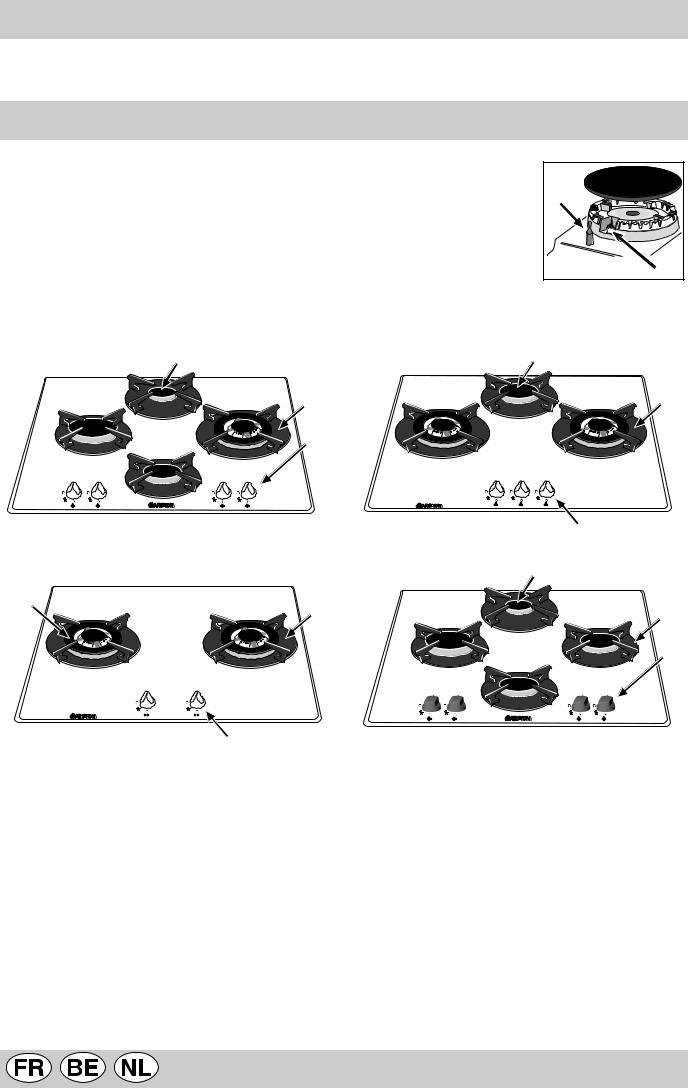
Merci d'avoir choisi un produit Ariston, fiable et facile à utiliser. Pour mieux le connaître et l'utiliser le plus longtemps possible, nous vous conseillons de lire attentivement ce livret. Merci.
Vu de près
A.Brûleurs gaz
B.Grilles support de casseroles
C.Manettes de commande des brûleurs gaz
D.Bougie d'allumage des brûleurs gaz (présente uniquement sur certains modèles)
F.Dispositif de sécurité(n'existe que sur certains modèles) - Intervient en cas d'extinction accidentelle de la flamme (débordement de liquides, courants d'air,
...) en interrompant automatiquement l'arrivée de gaz.
F |
D |
A
B C
A
B
C
A
A |
|
B |
B |
|
|
|
C |
C
18
